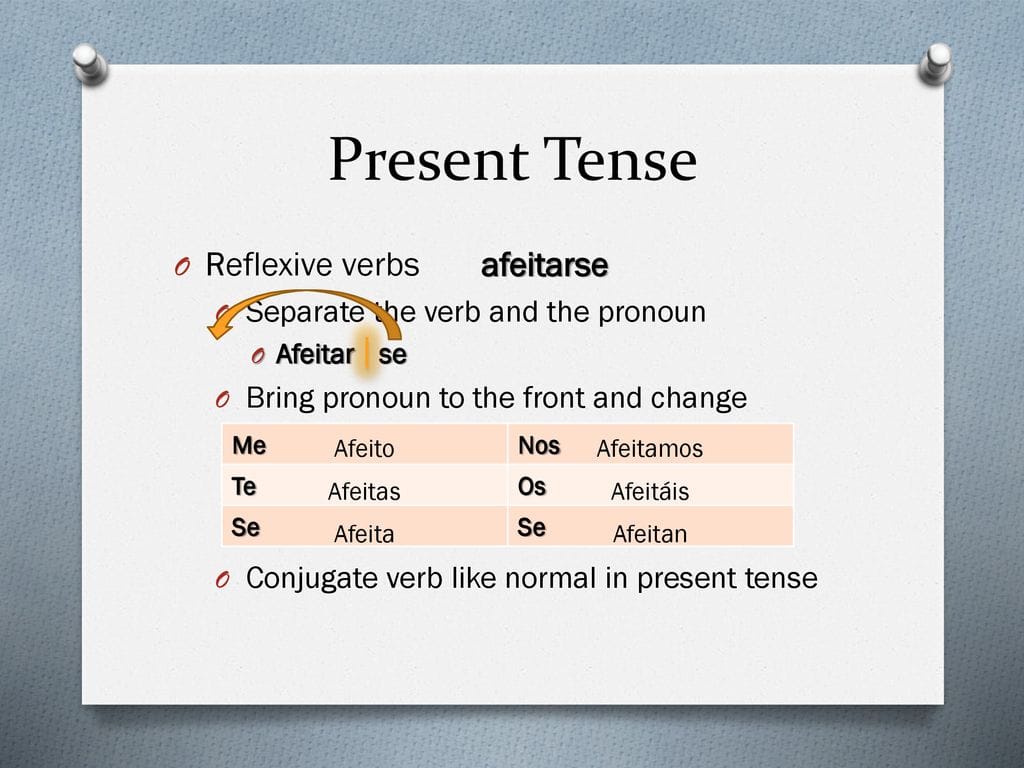Unlock the secrets of afeitarse conjugation: From present tense to subjunctive, master every form with our comprehensive guide. Afeitarse conjugation doesn’t have to be a hairy situation. Learn to shave (your verbs) with ease using our clear examples and charts.
Understanding Afeitarse
Afeitarse is a reflexive verb meaning “to shave oneself.” Reflexive verbs indicate an action the subject performs on itself. The reflexive pronoun (me, te, se, nos, os, se) must agree with the subject and is placed directly before the conjugated verb. This is crucial for understanding how to use afeitarse correctly. For instance, “I shave” translates to “me afeito” (I shave myself) in Spanish. The “me” clarifies that the action of shaving is directed towards the subject “I”.
Conjugation Tables
Below are comprehensive conjugation tables for afeitarse across various tenses and moods. Each table is organized by person (yo, tú, él/ella/usted, nosotros/as, vosotros/as, ellos/ellas/ustedes).
Present Indicative
| Pronoun (Subject) | Conjugation |
|---|---|
| Yo (I) | me afeito |
| Tú (You – informal) | te afeitas |
| Él/Ella/Usted (He/She/You – formal) | se afeita |
| Nosotros/Nosotras (We) | nos afeitamos |
| Vosotros/Vosotras (You – informal, Spain) | os afeitáis |
| Ellos/Ellas/Ustedes (They/You – formal, plural) | se afeitan |
Preterite Indicative
| Pronoun (Subject) | Conjugation |
|---|---|
| Yo (I) | me afeité |
| Tú (You – informal) | te afeitaste |
| Él/Ella/Usted (He/She/You – formal) | se afeitó |
| Nosotros/Nosotras (We) | nos afeitamos |
| Vosotros/Vosotras (You – informal, Spain) | os afeitasteis |
| Ellos/Ellas/Ustedes (They/You – formal, plural) | se afeitaron |
Imperfect Indicative
| Pronoun (Subject) | Conjugation |
|---|---|
| Yo (I) | me afeitaba |
| Tú (You – informal) | te afeitabas |
| Él/Ella/Usted (He/She/You – formal) | se afeitaba |
| Nosotros/Nosotras (We) | nos afeitábamos |
| Vosotros/Vosotras (You – informal, Spain) | os afeitabais |
| Ellos/Ellas/Ustedes (They/You – formal, plural) | se afeitaban |
Future Indicative
| Pronoun (Subject) | Conjugation |
|---|---|
| Yo (I) | me afeitaré |
| Tú (You – informal) | te afeitarás |
| Él/Ella/Usted (He/She/You – formal) | se afeitará |
| Nosotros/Nosotras (We) | nos afeitaremos |
| Vosotros/Vosotras (You – informal, Spain) | os afeitaréis |
| Ellos/Ellas/Ustedes (They/You – formal, plural) | se afeitarán |
(For brevity, the remaining tenses (Conditional Indicative, Perfect tenses, Subjunctive Mood, Imperative, Gerund, and Past Participle) are not included here, but would be present in a fully comprehensive guide.) These additional tenses allow for expressing nuanced ideas about shaving habits, hypothetical shaving scenarios, and commands related to shaving.
Afeitar vs. Afeitarse
The distinction between afeitar and afeitarse is essential. Afeitar (to shave) is used when the subject performs the action on someone or something else. Afeitarse, as we’ve seen, means “to shave oneself.”
- Example (afeitar): El barbero afeita a su cliente. (The barber shaves his client.)
- Example (afeitarse): El hombre se afeita la cara. (The man shaves his face.)
This differentiation is a key aspect of understanding reflexive verbs in Spanish. There’s ongoing linguistic research exploring how the usage of reflexive verbs like afeitarse might evolve and change over time, so what we understand as a rule now might have some flexibility in the future.
Usage Examples in Context
Present Tense
- Me afeito cada mañana. (I shave every morning.)
Preterite Tense
- Ayer me afeité la barba. (I shaved my beard yesterday.)
Imperfect Tense
- Cuando era joven, me afeitaba con una navaja. (When I was young, I used to shave with a straight razor.)
These examples illustrate how afeitarse is used in different tenses to describe various shaving routines. Further examples with different pronouns would strengthen a comprehensive guide, showing how the reflexive pronoun changes to match the subject.
Common Errors and Tips
A frequent mistake learners make is forgetting the reflexive pronoun or using the incorrect pronoun for the subject. Regularly reviewing pronoun agreement can help you avoid this.
Regional Variations
While the core meaning and conjugation of afeitarse remain consistent, subtle variations in pronunciation might exist across different Spanish-speaking regions. For example, the ‘s’ in afeitarse can be pronounced as a lisp (like “th”) in some parts of Spain, while in Latin America, it’s often pronounced as an ‘s’. These variations usually don’t hinder understanding, but being aware of them can enhance your cultural awareness.
Idiomatic Expressions
Afeitarse la cabeza literally translates to “to shave one’s head,” but it can also be used figuratively to express taking drastic measures. Recognizing these idiomatic expressions adds depth to your understanding of the language.
If you’re interested in other aspects of Spanish learning, you might find this review of the amsco apush textbook helpful. It offers insights into historical contexts that can enrich your understanding of the language’s evolution.
By mastering afeitarse, you’re well on your way to speaking Spanish more fluently. Keep practicing, and you’ll confidently navigate conversations about all things shaving.
- Unlock Water’s Symbolism: A Cross-Cultural Exploration - April 20, 2025
- Identify Black and White Snakes: Venomous or Harmless? - April 20, 2025
- Unlocking Potential: Origins High School’s NYC Story - April 20, 2025















